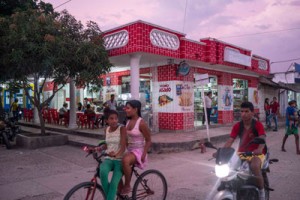In search of echoes of a novel
A museum more magical then real
Your arrival in Aracataca has been timed to coincide with the 50th anniversary of the publication of One Hundred Years of Solitude. A sign on one wall welcomes us to the ‘Land of the Nobel’, another bears testimony to the place the sleepy town held in Gabo’s life and work: ‘Aracataca,’ reads the quote from the author,‘to which I returned one day and discovered that between reality and nostalgia was the raw material for my work.’
Your first stop is the railway station. You watch in wonder as the longest train that any of you has ever seen passes by; some 300 carriages loaded with ore from the mines thunders down the track without pause.
Another one of these monsters trundles by every thirty minutes. (When the train first arrived in Macondo, a woman is driven mad by the strangeness of a machine so loud that it sounds like “the kitchen dragging a village behind it.”)
From the houses nearby, the sounds of salsa are carried over by the wind.
Wandering through this town, you watch locals as they watch you. Your arrival appears to be the most interesting thing to happen today. In your survey of the town, you discover most of the roads are unpaved. They are lined by mango trees, heavy with small, sweet fruit; when you eat one, you stain your white dress.
The homes that line the dusty streets are simple and a long drought means few have running water. The town square is overrun with young children playing run and catch.

A day in the life of the locals of Aracataca. Pic by Stephen Ferry
Your host is a family in the village. You find loose pills on the mattresses in the doctor’s spare bedroom.
The big tourist attraction is the museum dedicated to Gabo. It is supposed to be his house, and yet his house was burned down to the ground many years ago. This unfaithful reconstruction includes bedrooms, a smithy for the making of gold fish and a study for his grandfather.
A bunch of bananas hangs in the corner of the dining room, with helpful directions for anyone who has never sampled one before: ‘You have to peel it before you eat it.’Everything here is a recreation; a kind of architectural magical realism.
Aracataca has long been embroiled in a fight to claim Gabo.
They have little to show for it. Gabo’s ashes are divided between Mexico City (where he spent much of his life in exile) and Cartagena de Indies. In 2014, the Harry Ransom Center at University of Texas celebrated the acquisition of his archive, including an unfinished novel. When the authorities set about building the museum in 2006, Gabo reviewed the blueprints of the $350,000 restoration but had little else to do with the project.
You are not entirely surprised to discover that people in this town are divided about Gabo. Over the years, residents have complained to visiting journalists with some bitterness of neglect; their most famous son should have given money to this town, they say, or at least arranged to give back to them after his death. Aracataca is left, for most part, only with memories.
While walking around, you are invited into the home of Aracataca’s former mayor; 86-year-old Carlos Nelson is one of Gabo’s oldest friends. “I drank with him before he was famous,” the bluff old man tells you.
Nelson knew the author first when they were both 16, and then again when Gabo was deported from Venezuela. Gabo came back then as an encyclopaedia salesman.
His profits never seemed to stretch much further than his next bottle of pure cane rum. “The bottle cost 60 cents at that time,” says Nelson.“I remember when he came, he would come crying: ‘I sold one, I sold one.’” The profits from the encyclopaedia sales went towards a worthy cause. “We would sit up and drink till eight or ten at night, and then start again the next day at noon. Sometimes we would steal chickens and cook them the following day.”
Aracataca was different then, remembers Nelson. “It was a small town. There was no aqua duct, and the water used to be delivered by truck. Everybody knew everybody else, and we slept with our doors open.” Today, Aracataca has many faces, as thousands of internally displaced people have been driven out of areas occupied by the guerrilla and right-wing paramilitary groups.
It is hard to find work, and the community is beset with drug-related crimes. Does Nelson recognize Aracataca in Macondo?
They are nothing alike, Gabo’s old friend tells you, his face closing off at what must be the most predictable of questions. “It’s completely different.”
The writer is a Gabriel García Márquez Cultural Journalism Fellow for 2017.


